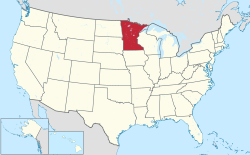 | |
| Number of elections | 42 |
|---|---|
| Voted Democratic | 21 |
| Voted Republican | 20 |
| Voted other | 1 [a] |
| Voted for winning candidate | 30 |
| Voted for losing candidate | 12 |
Following is a table of United States presidential elections in Minnesota, ordered by year. Since its admission to statehood on May 11, 1858, Minnesota has participated in every U.S. presidential election.
Contents
Winners of the state are in bold. The shading refers to the state winner, and not the national winner.
Minnesota is a signatory of the National Popular Vote Interstate Compact, an interstate compact in which signatories award all of their electoral votes to the winner of the national-level popular vote in a presidential election, even if another candidate won an individual signatory's popular vote. As of 2023, [update] it has not yet gone into force. [1]